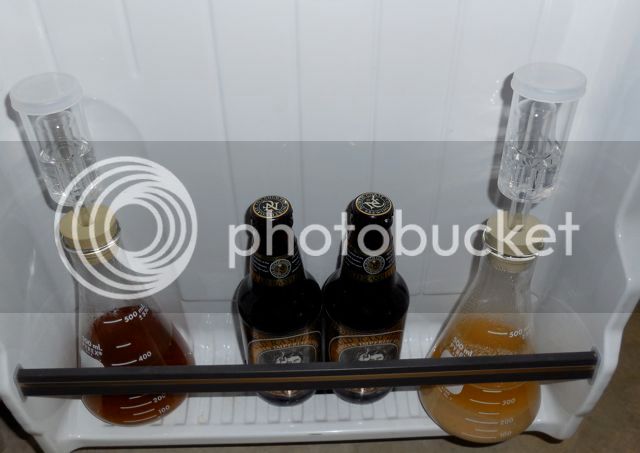[FONT="]
The problem is aquiring the thin slurry as when you slosh the beer and trub about then leave it for 20 mins to settle out - it doesn't.
I post as YeastWhisperer over on JBK. A lot of people are confused [FONT="]when it comes to using[/FONT] slurry pitching calculators. Slurry cropped from a conical is almost never pure yeast. It is a mixture of yeast cells, break, and small amounts of other organic matter. Roughly 40% to 60% of any given thick slurry is yeast. The remaining 40% to 60% is mostly break. At that ratio, one milliliter of slurry contains approximately 1.2 billion yeast cells[1] ; hence, 100ml of thick slurry contains approximately 120 billion yeast cells.
Additionally, yeast cultures are a little like nuclear weapons in that one does not have to be exact due to how yeast cells reproduce. A lot of brewers believe that yeast cultures grow linearly, that is, with [FONT="]a[/FONT] starting yeast cell count of 50 billion cells and a replication period of 90 minutes, most brewers would assume that [FONT="]the [/FONT]culture would contain 150 billion cells at 180 and 200 billion cells at [FONT="]270 [/FONT]minutes. However, yeast cells reproduce by budding, that is, a cell basically splits into two yeast cells when it reproduces. This type of growth pattern is known as exponential or logarithmic growth; hence, the terms exponential phase and log phase are used to describe the phase where the yeast cell population grows to fit its new home.
The yeast cell population grows at a rate of 2^n, where the symbol "^" denotes raised to the power of, and the variable n equals the clock time in m[FONT="]inutes[/FONT] that has elapsed in the log phase divided number of minutes in the replication period. This growth pattern means that the number of cells after 180 minutes of growth is 200 billion, not 150 billion. That number will double again to 400 billion at 270 minutes and 800 billion at 360 minutes if the carbon source (sugar is carbon bound to water) has not been depleted[FONT="], the mother cells have not [/FONT][/FONT][FONT="][FONT="]depl[FONT="]eted[/FONT][/FONT][/FONT][FONT="][FONT="][FONT="] their er[FONT="]gosterol and unsaturated fatty acid[FONT="] reserves, and[/FONT][/FONT][/FONT][/FONT] the culture has not reached maximum cell density, which is approximately 200 billion cells per milliliter (4.6 trillion cells for 23 liters).
[FONT="]number_of_ce[FONT="]lls_af[FONT="]ter_n_replica[FONT="]tion_periods = initial_yeast[FONT="]_cell_count [FONT="]* 2^n, wh[FONT="]ere n [FONT="]equals [/FONT][/FONT][/FONT][/FONT][/FONT][/FONT][/FONT][/FONT][/FONT][FONT="][FONT="][FONT="][FONT="][FONT="][FONT="][FONT="][FONT="][FONT="]ela[FONT="]psed[/FONT][/FONT][/FONT][/FONT][/FONT][/FONT][/FONT][/FONT][/FONT][/FONT][FONT="][FONT="][FONT="][FONT="][FONT="][FONT="][FONT="][FONT="][FONT="][FONT="] time in[FONT="] the log phase in min[FONT="]utes d[FONT="]i[FONT="]vided by the replication period in minutes[/FONT][/FONT][/FONT][/FONT][/FONT][/FONT][/FONT][/FONT][/FONT][/FONT][/FONT][/FONT][/FONT]
Exponential growth is why yeast cultures are like nuclear weapons. The difference between a 100 billion cell culture and a 200 billion cell culture is roughly one [FONT="]replication[/FONT] period (roughly 90 minutes of propagation time if metabolism is not slowed by cold temperatures); hence, there is no need to fret over a cell count difference that is less than 100 billion cells. Cell health is as important if not more important than actual cell count because given enough oxygen (O2) and carbon, a yeast culture will grow to fill its new home.[/FONT]
[FONT="]My advice when pitching yeast is to pitch for desired performance. When pitching beers in the 1.048 range, I usually pitch between 3 and 10 billion cells per liter. The higher the yeast cell count, the less a yeast strain will exhibit its character. The lower the cell count, the more a yeast strain will exhibit its character. I pitch British strains in the 3 to 5 billion cells per liter range because I am not looking for an ester-free American-style fermentation. I want the yeast strain to express its unique signature. That extra replication period makes a difference in the final beer.
Finally, one does not slosh the fermentation vessel when cropping, one swirls the vessel. This action leads to the break and dead cells settling out quickly, leaving viable cells and the lightest break material in suspension. It takes practice to be able to decant the thin slurry from the heaviest matter when performing the operation with a 23L or larger fermentation vessel; therefore, it may benefit a brewer to swirl the sediment back into solution and decant the entire contents into a sanitized 1-gallon demijohn. After the transfer has been completed, the solids can be swirled again, and the thin slurry can be cropped after waiting a few minutes for the heaviest particulate matter to settle. One should only take the top 350 to 400 ml of thin slurry.[/FONT]
[FONT="]Here's what a crop should look like:[/FONT]
[FONT="]
[/FONT]
[FONT="]Neither of the crops shown above were pure yeast, but both were highly effective when repitched. [FONT="]Neither crop was rinsed with water.[/FONT][/FONT]












![BREWING THERMOMETER STICKERS ACCURATELY MONITOR FERMENTING BEER & WINE LIQUID TEMPERATURES 5PCS HOME BREW SPIRITS WINE LCD ADHESIVE [US]](https://m.media-amazon.com/images/I/311DDjo2X3L._SL500_.jpg)






























